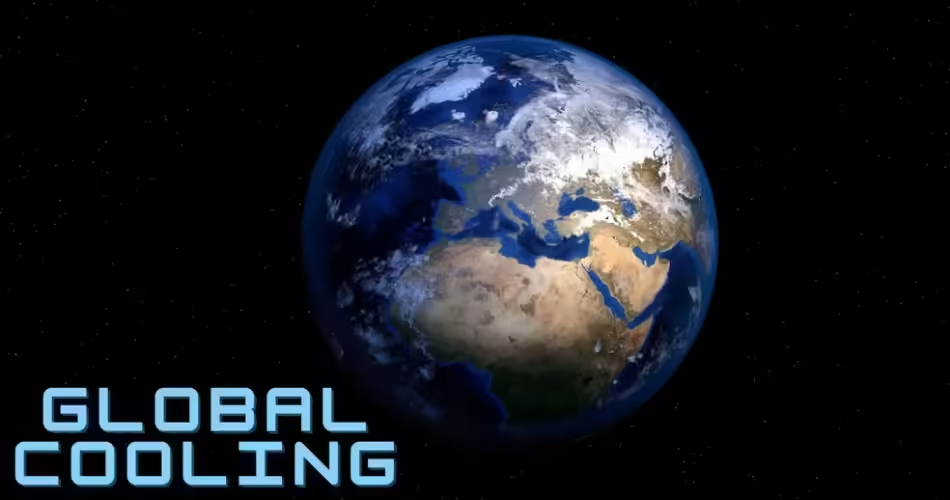This blog will explain the concept of Global Cooling. At first, we will elaborate the concept of Global Cooling. Then we will name the Causes of Global Cooling. At second, we will discuss the difference between Global Cooling and Global Warming. Then we will have the detailed explanation of Causes of Global Cooling. At the end, we will discuss the Effects of Global Cooling on Earth and Environment. This blog contains Concept, Causes and Effects of Global Cooling in detail.
What is Global Cooling?
Global cooling is the gradual decrease in average temperature over an extended period. It is the natural periodic change in global temperature by few specific processes.
Earth has experienced both Global Warming and Global Cooling in different periods of time. Basically the periods of Earth’s Extreme Glaciation was called as Global Cooling Period.
In 1970s, the latest temperature series available suggested that the temperature had decreased to several decades up to then.
The main causes of global cooling phenomenon are aerosols, orbital forces, volcanic eruptions and other natural phenomena that have a cooling effect on Earth.
Contrary to what you might expect, global cooling doesn’t mean that winters suddenly become Arctic-like across the globe. Instead, it refers to a gradual decrease in global temperature.
This phenomenon often occurs alongside, or even in spite of, the overarching trend of global warming. Global cooling is not abrupt but it is visibly very slow and continue through many years but may cause serious effects in long-term. This blog contains Causes and Effects of Global Cooling.
Causes of Global Cooling:
Research suggests that global cooling can be influenced by various factors as follows:
Solar activity
Natural climate cycles (such as the Pacific Decadal Oscillation (PDO) and the Atlantic Multi-decadal Oscillation).
Human activities (greenhouse gas emissions)
All these factors play a significant role in driving global warming, they can also have complex effects on regional and seasonal temperatures, sometimes leading to unexpected cooling trends.

Global Cooling Vs Global Warming:
Cooling:
- It is the natural process of gradual decrease in average temperature of the Earth.
- It provides cooling effect to the Earth.
- It is mostly caused by natural activities that occurs on the Earth.
- Its effects include Glaciation, Cooling down of the surface through volcanic ash etc.
- At present, the global cooling is not dominating on Earth.
- Causes: Volcanic Eruption, NCO, Particulate pollution etc.
Warming:
- It is the natural process of gradual increase in average temperature of the Earth.
- It provides warming effect to the Earth.
- It is mostly caused by the anthropogenic (human) activities that occurs on the Earth.
- Its effects include melting of Glaciers and Sea level rise etc.
- At present, the global warming is dominating on Earth.
- Causes: Burning of Fossil Fuel, Deforestation, Heat Trapping Pollution etc.
Following are the explanation of Causes of Global Cooling:
1: Solar Activity
The sun, our ultimate source of warmth and light, undergoes cycles of activity that can impact Earth’s climate. During periods of low solar activity, known as solar minima, the sun emits less energy, which can contribute to cooler temperatures on our planet. Recent research, such as the study by Lockwood et al. (2018), highlights the potential link between solar variability and regional cooling patterns, shedding light on this intricate relationship.
2: Volcanic Eruptions: Nature’s Cooling Mechanism
When volcanoes erupt, they spew vast amounts of ash and gases into the atmosphere, forming a veil that can reflect sunlight back into space. This phenomenon, known as volcanic cooling, can lead to temporary but noticeable drops in global temperatures. The landmark eruption of Mount Pinatubo in 1991 serves as a poignant example of how volcanic activity can temporarily offset the warming trend, offering researchers valuable insights into Earth’s climate system. Volcanic gases such as SO2 are a great cause of global cooling. This gas cools down the Earth’s atmosphere and creates a cooling effect in on Earth after volcanic eruption. If we observe visually then it seems like volcanoes are warming the earth, but eventually volcanoes throw out all the heat inside the Earth and the ash provide the cooling effects to the surface of the Earth. That is why, this phenomenon is called as Volcanic Cooling.
3: Natural Climate Oscillations: Unraveling the Mysteries
Natural Climate Oscillations are the recurring cyclic oscillations within global or regional level. It includes natural variations in climatic patterns over a period of time. These oscillations have been recognized by different timescales that may be from intra-seasonal to millennial and at spatial scales. These variations or oscillations can have different impacts either global or regional. These are the cause of extreme impacts on Global level Including Global Cooling. Two examples of NCO are as follows:
PDO (Pacific Decadal Oscillation):
The Pacific Decadal Wavering (PDO) is a drawn out sea vacillation of the Pacific Sea. The PDO fluctuates around each 20 to 30 years. From sea surface geology information, along with other sea and climatic information, researchers can decide if we are in a ‘cool’ stage or a ‘warm’ stage. The PDO is an active topic for satellite data and research because it helps scientists observe and understand the phenomenon by this Oscillation. This is an important natural cycle. The adjustment of area of the cold and warm water masses modifies the way of the fly stream. Set forth plainly, the fly stream in the northern side of the equator conveys storms across the US. The PDO stage that we seem to have entered will act to control the fly stream further north over the Western US.
AMO (Atlantic Multi-Decadal Oscillation):
The AMO is a continuous series of long-length changes in the ocean surface temperature of the North Atlantic Sea, with cool and warm stages that might keep going for 20-40 years all at once and a distinction of around 1°F between limits. These progressions are regular and have been happening for essentially the most recent 1,000 years. The AMO has impacted air temperatures and precipitation over a large part of the Northern Side of the equator, specifically, North America and Europe. It is related with changes in the recurrence of North American dry spells and is reflected in the recurrence of serious Atlantic storms. It on the other hand darkens and misrepresents the worldwide expansion in temperatures because of human-prompted an unnatural weather change.
4: Human Activities:
Human activities also influence Global Cooling. It means that the anthropogenic practices that are involved in the causes of global cooling. Human Activities have been adding to the global cooling factor of the Earth. But we can say that humans are participating in Global warming more than Global Cooling. And most of the global cooling is caused by Natural Earth Cycles or natural activities of Earth’s Systems. Particulate Pollution is one of the major artificial cause of Global Cooling.
Particulate Pollution:
It includes mixture of solid and liquid droplets suspended in the air. Some of those particles such as dust, smoke, dirt, soot etc. are dark in enough to be seen with naked eye. This pollution stay persistent in the environment for a long time and cast a cooling effect on the environment. This pollution arises from Vehicle exhausts, wood burning, gas, tobacco smoke, broiling and frying food, burning candles or oil lamps, fireplaces etc.
These are few factors that influence Global cooling. After discussing the Causes, we will discuss the Effects of Global Cooling.
Effects of Global Cooling:
Following are the two major effects:
Decrease in Temperature:
Due to the natural system of global cooling, some regions are getting colder with passing time. There is a significant decrease in temperature in specific regions of the world. For example Europe and North America are approximately 20°C colder than in the past, and Tropical Regions are 2°C colder than it was in the past. This is because of global cooling that is impacting of the global level, because it is decreasing average temperature of the Earth.
Development of Ice Caps:
Global Cooling involves in the development of ice caps so these ice caps are made by freezing temperatures in freezing regions. This contributes in decreasing the sea level, producing land bridges and changing the environment for flora and fauna. This helps in conserving fresh water in the ice caps and glaciers, so that it can be used by the future generations for drinking purposes. This phenomenon conserves the nature by providing habitats to animals, fishes and protects fresh water.
These are the two main effects of Global Cooling.
Embracing the Chill: Finding Opportunity amidst Change
While the prospect of global cooling may evoke visions of icy landscapes and frigid winters, it’s essential to approach this phenomenon with a balanced perspective. Instead of viewing it solely through the lens of alarmism, we can choose to see it as an opportunity to adapt and innovate. From advancements in cold-resistant crop varieties to the development of energy-efficient heating technologies, there are countless ways in which society can thrive in a cooler world.
Conclusion:
As we go through the ever-changing landscape of Earth’s climate, it’s crucial to embrace the complexities and uncertainties that accompany phenomena like global cooling. By fostering a spirit of curiosity, collaboration, and resilience, we can navigate these challenges with confidence and ingenuity. So, let’s welcome the chill with open arms, knowing that our collective efforts can illuminate the path towards a more sustainable and harmonious future for generations to come. Remember, as we delve into the intricacies of global cooling, let’s keep an open mind and continue to explore the wonders of our planet’s climate system together. This blog contains concept, Causes and Effects of Global Cooling.

To learn more, Click the links below:


Comments